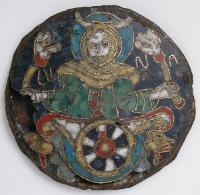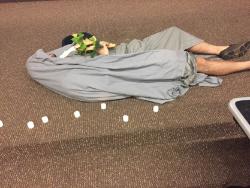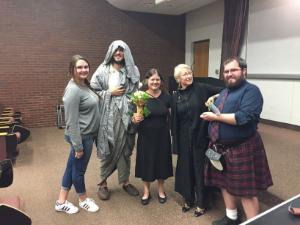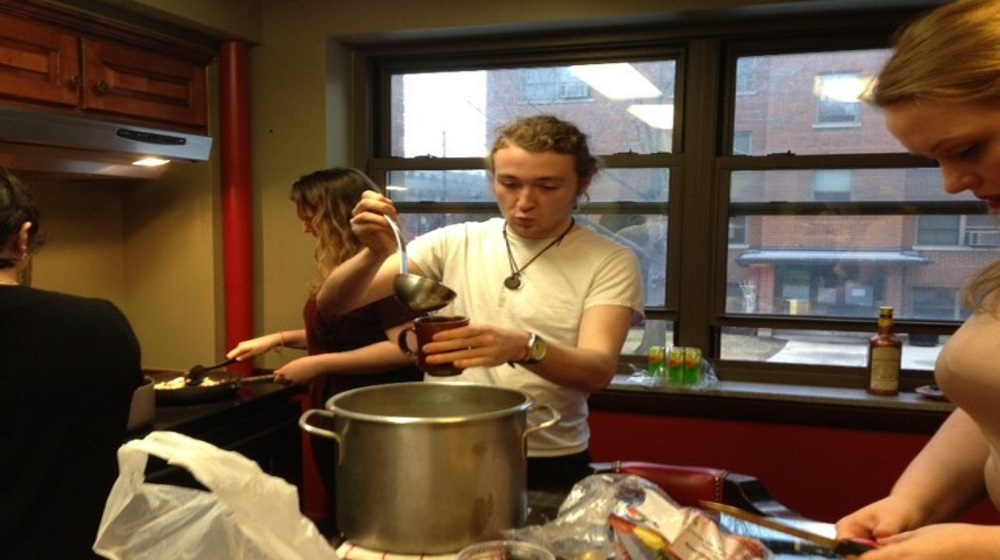archive
MEDIEVAL NIGHTS!: 2017-18 LECTURE SERIES
The night was dark and full of terrors-- But it was also entertaining!

On October 4 the Medieval Studies program explored the questions: What did ancient and medieval people do after the sun went down? Did they admire the night sky or fear the darkness?
While Dr Dossey explored changes in the ways Greeks and Romans viewed the night – changes possibly related to increasing urbanization – Dr Gross-Diaz gave examples of how and why those views morphed in the Middle Ages. From werewolves to lunar eclipses, from astrology to travel, the night experience was shared by nearly 100 students in Crown Auditorium which, for this event, was made completely and totally dark!

The highlight of the evening was Dr Dossey and her student assistants performing an ancient Greek necromantic spell which raised this “corpse” to life and conjured it to foretell the outcome of one student’s exams (hint: never trust a corpse).

35th Annual Meeting of the Illinois Medieval Association
Loyola University Chicago, Watertower Campus, 16-17 Februrary, 2018
Medievalists have long engaged in the study of the body, producing some of the most influential contributions to the “bodily turn” of the 1980s and 1990s. The multidisciplinary conference “Reframing Medieval Bodies” invites reflection on past scholarship in this area and elaboration of new approaches and methods. We invite papers from the full range of disciplines in medieval studies, exploring bodies in their physiological, symbolic, political, economic, and performative capacities. Papers that revisit "the body" in light of bioarchaeological research and the history of medicine are especially welcome, as are papers that engage recent research on disability, gender, and race.
We are delighted to announce our keynote speaker: Peggy McCracken, Domna C. Stanton Professor of French, Women’s Studies, and Comparative Literature at the University of Michigan.
We welcome proposals for either individual papers or whole sessions. Proposals for individual papers should be limited to 300 words. Session proposals should include abstracts for the three papers as well as the contact information for all presenters.
Abstracts on any aspect of medieval studies are welcome, but we will give preference to submissions related to the conference theme. Submit proposals to ima2018loyola@gmail.com no later than December 1, 2017.
Papers presented at “Reframing Medieval Bodies” are eligible for publication in the journal Essays in Medieval Studies. Questions may be directed to tstabler@luc.edu or icornelius@luc.edu.
A “Taste of Medieval England” included mac and cheese, pretzels, and cheesecake – who knew?

A “Taste of Medieval England” included mac and cheese, pretzels, and cheesecake – who knew?
We found out as we researched material culture in Medieval England (HIST 329). Using cookbooks from fourteenth-century England and France, we created a menu such as might have been enjoyed at the abbot’s table of a fairly unreformed Benedictine monastery: no meat, but plenty of cheese and eggs. (No beer or wine, of course, per University regulations… ) Our recipes came from Forme of Cury, the Liber Cure Cocorum, and Le Ménagier de Paris, by way of scholarly editions by R. Morris, Constance Hieatt and Sharon Butler , and Eileen Power; handily made available through websites Godecookery and Medieval Cookery. We decided that during dinner we would “share news” about the goings-on in England and elsewhere during the Anarchy. We worked on the reasonable assumption that the recipes and ingredients would not have changed a great deal in England in the period after the Norman Conquest but before the sixteenth century.
We began with a potage de Crécy, made from carrots (a specialty of the Norman city of Crécy – right across the Channel and part of “greater England” at this time). This soup would later be enjoyed on the anniversary of England’s victory over French forces near that town in 1346, during the Hundred Years War. Since we were in England, we added parsnips to the traditional recipe. The soup course was followed by makerouns (a dish of cheddar cheese and egg noodles that tasted curiously familiar), frutours (apple sliced fried in beer batter), mushroom pasty (or “funges in a coffyn”, made with “local” English cheddar instead of a French cheese), and a refreshing salat full of herbs and tasty greens (lacking the primrose and violet petals which are, alas, in short supply in Chicago in early March). Medieval pretzels, freshly baked from scratch, helped wipe up the savory juices on our plates, and we finished on a sweet note with sambocade, a cheesecake made with aromatic elderflowers. Great goblets of small mead (sans alcohol) washed it all down as we traded news about Matilda and Stephen and their desperate contest, as well as echoes of happenings as far afield as Compostela and Rome.
We could not agree as to whether Matilda or Stephen would be the better ruler of England and Normandy; but we did agree that a 300-level “Medieval Food” course would be a great asset to Medieval Studies and the History Department!
Student participants: Vivianne Arellano, Austin Edington, John Garrity, Leah Henning, Aaron Kinskey, Alexis Kloiber, Katherine Russell, Katherine Zoibro.
Our special thanks to Fr. Daffron and Tivo, who let us use their kitchen in Campion! Click below for more pictures from the event!
--T. Gross-Diaz
Associate Professor, History
Director, Medieval Studies
